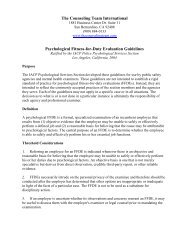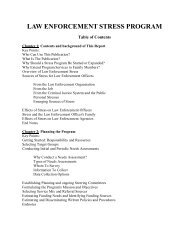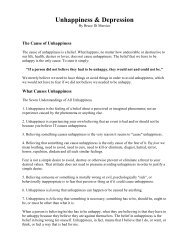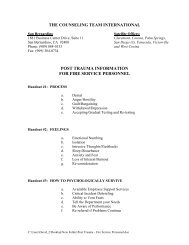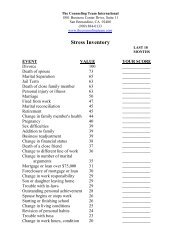ISSUES AND PRACTICES.pdf - The Counseling Team International
ISSUES AND PRACTICES.pdf - The Counseling Team International
ISSUES AND PRACTICES.pdf - The Counseling Team International
Create successful ePaper yourself
Turn your PDF publications into a flip-book with our unique Google optimized e-Paper software.
After the riot ended, the president of the correctional officers union local at the time went to thecommissioner to request that the PISD policy on offering debriefings be implemented. <strong>The</strong>commissioner agreed, authorizing the facility superintendent to go forward with debriefingswhen facility operations returned to normal. <strong>The</strong> superintendent in turn authorized the unionpresident and the EAP coordinator at the facility to initiate the process and to schedule thedebriefings.Working from a list of employees who had been on duty the afternoon and evening of the riot,the union president and the EAP coordinator in person and by phone invited dozens ofemployees to attend the debriefings, which were also announced at the beginning of every shiftand at lineup for several days. All told, 400 staff were invited to attend.DebriefingsWhile the union president and EAP coordinator assembled officers for the debriefings, thedepartment's assistant commissioner convened the debriefing team.A line officer from another facility received an e-mail from his supervisor telling him to go toMohawk "for a day." <strong>The</strong> officer was selected because he was the EAP coordinator at his prisonand a trained debriefer who had conducted more than 50 debriefings as part of his volunteerpublic safety work outside the department. He remained as lead debriefer for 6 days, went back aweek later for 2 more days, and then returned for 2 final days in August to check on the wellbeing of the most severely affected officers.According to a captain certified in critical incident debriefing who co-led several sessions duringthe first week,Twenty-five officers directly involved in the incident showed up the first day. As a result ofword of mouth, their backups showed up the second day. <strong>The</strong> third day's session includedinstitution nurses and physician's assistants who had found it stressful to administer tocorrectional staff-some of whom were their neighbors outside the facility-rather than to theinmates they were accustomed to treating.Of the 400 staff members invited, 180 attended at least one of 15 debriefing sessions lasting 2 to6 hours each. All sessions were held outside the prison complex. <strong>The</strong> sessions included groupdiscussions and one-on-one support. A mental health professional co-led every debriefing.ReferralsAfter the sessions, debriefers referred 12 officers to EAP coordinators, who arranged forprofessional counseling. <strong>The</strong> facility EAP coordinator obtained professional help for 10 to 15officers who were referred to him or came to him on their own asking for help. "<strong>The</strong>y probablywould not have come to me for help if they had not attended the debriefings," he says, "or theymight have waited until things got a lot worse." Later, he learned that several of them saw thecounselor to whom he had referred them once a week for 2 or 3 months. Others talked to thecounselor once. Some brought their spouses to the first one or two sessions.




